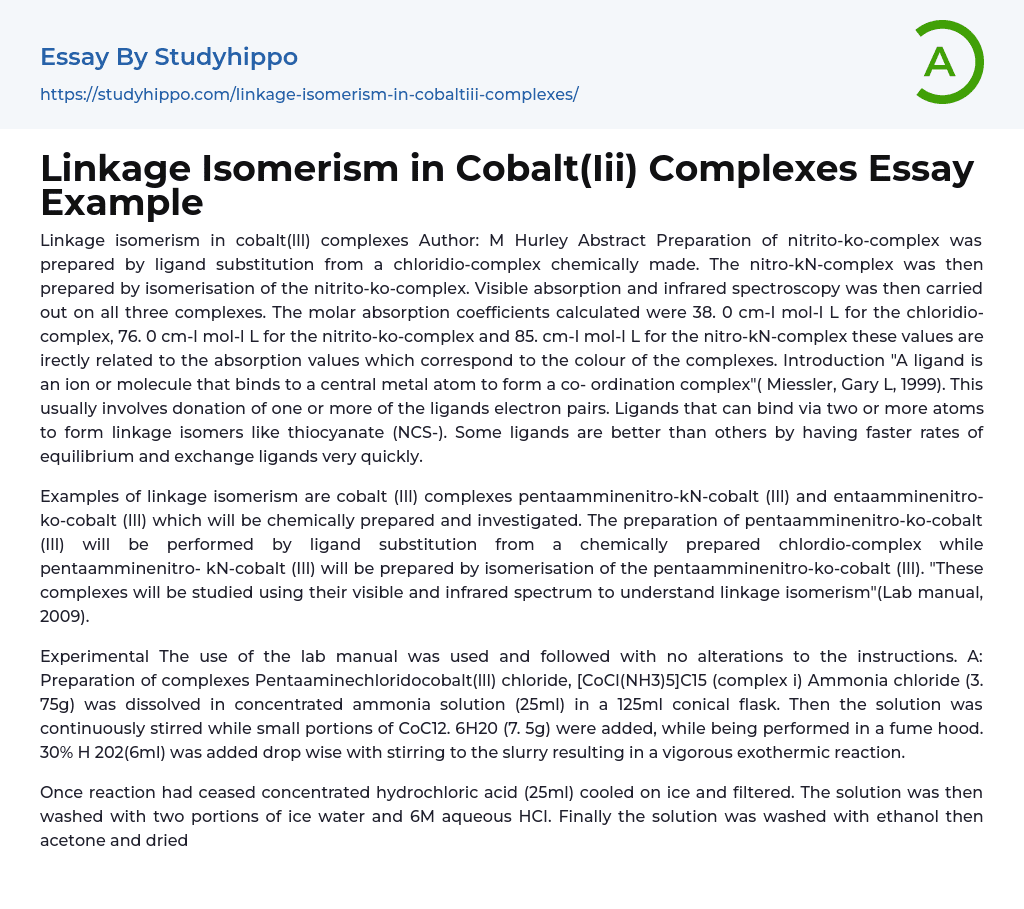Abstract
Preparation of nitrito-ko-complex was prepared by ligand substitution from a chloridio-complex chemically made. The nitro-kN-complex was then prepared by isomerisation of the nitrito-ko-complex. Visible absorption and infrared spectroscopy was then carried out on all three complexes. The molar absorption coefficients calculated were 38. 0 cm-l mol-l L for the chloridio-complex, 76. 0 cm-l mol-l L for the nitrito-ko-complex and 85. cm-l mol-l L for the nitro-kN-complex these values are irectly related to the absorption values which correspond to the colour of the complexes.
Introduction
"A ligand is an ion or molecule that binds to a central metal atom to form a co- ordination complex"( Miessler, Gary L, 1999). This usually involves donation of one or more of the ligands electron pairs. Ligands that can bind via two or more atoms to form linkage isomers like thiocyanate (NCS-). Some ligands are better than others by having fa
...ster rates of equilibrium and exchange ligands very quickly.
Examples of linkage isomerism are cobalt (Ill) complexes pentaamminenitro-kN-cobalt (Ill) and entaamminenitro-ko-cobalt (Ill) which will be chemically prepared and investigated. The preparation of pentaamminenitro-ko-cobalt (Ill) will be performed by ligand substitution from a chemically prepared chlordio-complex while pentaamminenitro- kN-cobalt (Ill) will be prepared by isomerisation of the pentaamminenitro-ko-cobalt (Ill). "These complexes will be studied using their visible and infrared spectrum to understand linkage isomerism"(Lab manual, 2009).
Experimental
The use of the lab manual was used and followed with no alterations to the instructions. A: Preparation of complexes Pentaaminechloridocobalt(lll) chloride, [CoCl(NH3)5]C15 (complex i) Ammonia chloride (3. 75g) was dissolved in concentrated ammonia solution (25ml) in a 125ml conical flask. Then the solution was continuously stirred while small portions
of CoC12. 6H20 (7. 5g) were added, while being performed in a fume hood. 30% H 202(6ml) was added drop wise with stirring to the slurry resulting in a vigorous exothermic reaction.
Once reaction had ceased concentrated hydrochloric acid (25ml) cooled on ice and filtered. The solution was then washed with two portions of ice water and 6M aqueous HCI. Finally the solution was washed with ethanol then acetone and dried. pentaamminenitro-ko-cobalt (Ill) chloride, [co(NH3)5(ONO)]C12 (complex it) A solution of concentrated ammonia(3ml) in water(32ml) was made and continuously stirred on a steam bath until solution was at about 70C. Then pentaanninechlorideocobalt(lll)(2g) was added and dissolved without boiling.
The filtrate was transferred to a clean beaker and cooled to 10C in an ice bath. 2M aqueous HCl(3. 2ml) was then added drop wise with stirring and cooling until the pH of the solution was neutral. Then sodium nitrate(2g) was added and dissolved ollowed by 6M aqueous HCI solution(2ml) The solution was then kept in an ice bath for about one hour and filtered for the crystalline product. The product was washed with 4ml portions of ice water followed by 10ml of ethanol in portions and finally with 10ml of diethyl ether and dried.
The yield of the product was then calculated. Pentaamminenitrito-N-cobalt (Ill) chloride, [Co(NH3)5(ONO)]C12 (complex iii) 0. 4g of the prepared pentaamminenitrito-ko-cobalt (Ill) chloride was dissolved in hot water(5ml) containing 1 to 2 drops of concentrated ammonia solution by stirring and eating on a water bath without heating for too long. Then the solution was cooled to room temperature by standing. Concentrated HCL(4ml) was then added with the solution being thoroughly cooled in an ice
bath with filtration once solution had crystallised and dried.
The yield was then calculated and UV vis and IR spectra of all three products were obtained as described below. B: Visible absorption spectroscopy The amount of each complex was calculated in order to prepare solutions of about IOA-2 - IOA-3 concentration in a 25cm3 in a flask. The amount of each complex was weighed and filled with distilled water. The spectrum was then measured over the range of 400-700nm this was done immediately after the solution was made up. Then extinction coefficients were calculated for each complex using Beer's law.
- Accounting essays
- Marketing essays
- Automation essays
- Business Cycle essays
- Business Model essays
- Business Operations essays
- Business Software essays
- Corporate Social Responsibility essays
- Infrastructure essays
- Logistics essays
- Manufacturing essays
- Multinational Corporation essays
- Richard Branson essays
- Small Business essays
- Cooperative essays
- Family Business essays
- Human Resource Management essays
- Sales essays
- Market essays
- Online Shopping essays
- Selling essays
- Strategy essays
- Management essays
- Franchising essays
- Quality Assurance essays
- Business Intelligence essays
- Corporation essays
- Stock essays
- Shopping Mall essays
- Harvard Business School essays
- Harvard university essays
- Trade Union essays
- Cooperation essays
- News Media essays
- Waste essays
- Andrew Carnegie essays
- Inventory essays
- Customer Relationship Management essays
- Structure essays
- Starting a Business essays
- Accounts Receivable essays
- Auditor's Report essays
- Balance Sheet essays
- Costs essays
- Financial Audit essays
- International Financial Reporting Standards essays
- Tax essays
- Accountability essays
- Cash essays
- Principal essays




